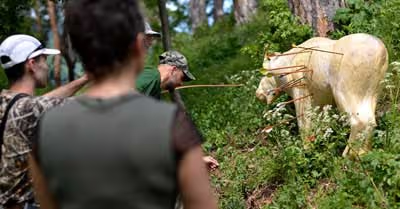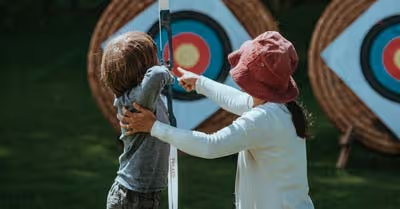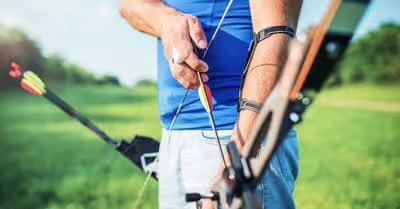Table of Contents
Common Archery Range Rules
Listen to staff members
It is rare for people to get hit by arrows on the range. This is because archery ranges set and enforce rules. The staff members are there to help keep everyone safe.
Medications that interfere with clear thinking might not be allowed
Any kind of medication you might not want to drive or operate heavy equipment with can be unsafe on an archery range. An archery range might have a rule against medication that can make you drowsy or impair your judgment.
You cannot drink alcohol before practicing archery. This should be obvious, but some people break this rule. It doesn't take very much alcohol to make driving more dangerous, and the same is true for archery.
Loose clothing might not be allowed
Loose clothing can make many activities less safe because it can get caught in something. If you are operating some equipment, loose clothing can get caught in the machinery and seriously injure you.
When you are shooting a bow, loose clothing can get caught in your bowstring. This is more than a little dangerous - the arrow can fly off in an unintended direction.
Some ranges may also have problems with long hair (unless it is pulled back), necklaces, earrings, and anything else that could get caught on a bowstring. These things can all lead to someone losing control of an arrow.
Protective equipment might be mandatory
Archery ranges have to keep their insurance companies happy, so they will do everything they can to prevent even minor injuries. The range might insist that everyone wears arm guards and sometimes also finger tabs.
Most archers wear arm guards, whether they are mandatory or not. An armguard can save you from a painful slap if the bowstring hits your arm. This hurts more than a little and can give you a serious bruise.
You may also have to wear gloves or finger tabs when you shoot. Finger tabs and gloves can prevent blisters on your fingers.
Running and horseplay are not allowed
This rule is aimed more at children and teenagers than adults, but it is an important rule for everyone to follow. If children run around or push and shove each other, then there is a chance someone could get hit with an arrow.
Running and horseplay are much more dangerous at an archery range than they are elsewhere. Ranges will enforce this rule and may kick people out if they repeatedly break it.
Inspect your gear before you shoot
While this may not be mandatory at your range, it is still a good safety practice. If a string breaks when you are pulling the arrow back, the string can whip back and hit you.
There can be bleeding and a lot of swelling in a string break injury. At worst, you could lose an eye if a snapping string hits you in the face, this is rare, but it is possible.
Bowstrings do not last forever - they might last for two or three years, but not much longer. Inspect your bowstring before you shoot. Look for tears and fraying.
You should also inspect your arrows before you shoot. Don't shoot if you have cracked arrows or loose arrowheads.
The riser or frame of the bow should also be free of cracks. Make sure that everything in your bow is securely attached and not loose.
Sometimes, a problem is so minor that it is safe to shoot despite it. Talk to someone at the range if you notice a slight bit of fraying on your bowstring or some other issue that seems minor.
Use a bow stringer to string your bow
If you are using a recurve bow, don't try to string it without using a bow stringer. The bow may pull back and hit you in the face if you string a compound bow improperly. Use a bow stringer instead of the unsafe push and pull method.
Don't aim at anything you don't intend to shoot
Whenever you have an arrow on your string, even if the bow is not pulled back all the way, you should only ever point the bow towards the targets. Only ever point the bow "downrange" - towards the targets, not in any other direction.
Ready and shoot your bow at the right time
Wait for instructions. Don't nock an arrow until you are instructed to. Everything has to be orderly and controlled at an archery range, so don't aim or shoot until the right time.
Take the line seriously
Any archery range has a line that you are not allowed to step across. By keeping everyone behind the line, they keep everyone safe from arrow hits. Not crossing the line is the most important rule at an archery range.
If you drop an arrow when getting ready to shoot it, it may fall onto the wrong side of the line. Don't cross the line to pick it up! Take the line seriously - it is not ok to briefly go a little across the line to get an arrow.
Use target points rather than hunting points at the range
A broadhead arrow is necessary when hunting because it is much more lethal than a smaller arrowhead. However, broadhead arrows do not offer any advantage when shooting targets. A broadhead arrow is a safety hazard and does not belong on the archery range.
Broadheads also do too much damage to targets. Archery ranges would have to replace targets more often if they allowed broadheads or other hunting points.
Never dry fire a bow
Dry firing is pulling the string back and letting the bowstring go without there being an arrow on the string. People usually dry fire accidentally by not paying attention to whether or not they have an arrow nocked. Dry firing can damage your bow easily - you do not have to do this many times to wreck your bow.
Dry firing is also unsafe because the bowstring can snap and cause injury. If you dry fire a rented bow, you can easily damage the archery range's equipment.
Someone must supervise children under 16
Usually, kids under 16 or 18 are supposed to have their parents or guardians with them at an archery range. This is not always necessary - they might have lessons, and parents might be able to leave when their kids are at lessons.
Crossbows may not be allowed
Probably most archery ranges allow crossbows, but many others do not. Crossbows can damage the targets, and a crossbow bolt can sometimes go through a target. Crossbows with a heavier draw weight are less likely to be allowed; the same is true for pistol style crossbows.
Don't aim upward when you pull the bow back
Some archers raise the bow when they are pulling the bow back. You might accidentally let the arrow go when you are pulling the bow back if you do this. Indoor ranges especially do not like this, as you can shoot the ceiling.
Don't shoot arrows that are too short
Shooting arrows that are too short for your bow is dangerous. If you pull a short arrow back too far, it can drop off your arrow rest.
If you shoot it, you could end up putting an arrow right through your hand. Archery ranges will not allow you to shoot with short arrows. Watch out for this problem yourself, because the staff at the range might not notice.
Use a bow you can pull easily
Pulling a bow back all the way is not supposed to strain your muscles. If you are straining to pull the bow back, it is harder to control, which can be dangerous. An archery range might have a rule against shooting if you are "over bowed" or straining to pull a bow with a high draw weight.
Don't retrieve your arrows until it's time
One of the worst things you can do is walk towards the targets to retrieve your arrows when other archers are still shooting. Don't walk across the line to get your arrows when other archers merely seem to have stopped shooting. Wait until the staff instructs people to do this.
Recent Articles
















